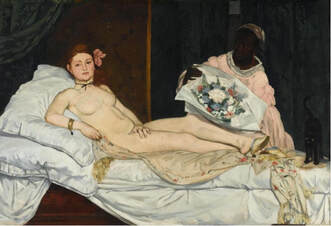 Edouard Manet, 'Olympia' (1863) Edouard Manet, 'Olympia' (1863) Art has been a powerful means of expressing the intricacies of human existence and emotions for centuries. One of the most intriguing aspects of art is its portrayal of the female body, which has been a subject of both fascination and controversy throughout history. From the classical representations of goddesses and muses to contemporary depictions of women, the male perspective on the female form has played a significant role in the world of art. In this blog, we will explore the fine line between objectification and the glorification of female beauty, examining how a male perspective can shape artistic interpretations. Throughout history, the male perspective on the female body has often resulted in the objectification of women. In ancient art, the female form was frequently idealized, portraying women as ethereal, unattainable beings, often as goddesses or nymphs. These idealized depictions often contributed to the objectification of women by presenting an unrealistic standard of beauty that was unattainable for most. The Renaissance period saw a shift in the representation of the female form, with artists like Leonardo da Vinci and Botticelli introducing a more realistic portrayal. However, even during this period, the male perspective continued to influence the depiction of women, emphasizing certain physical attributes that were considered desirable. In contemporary art, the male perspective on the female form has evolved, acknowledging the importance of celebrating female beauty while challenging traditional norms of objectification. Artists have begun to question societal standards of beauty, promoting diversity and inclusivity in their work. This transformation is a result of changing societal values and the influence of the feminist movement, which has brought the objectification of women into the spotlight. Artists like Gustav Klimt, Pablo Picasso, and Egon Schiele explored new facets of the female form, often depicting women in a more realistic and liberated manner. While their work celebrated female beauty, it also raised questions about the objectification of women and the power dynamics inherent in traditional depictions. As male artists, it is essential to recognize the responsibility we bear when portraying the female form. While we have the privilege of artistic expression, we must do so with respect, sensitivity, and awareness of the potential consequences of our work. Instead of perpetuating objectification, we can contribute to a more balanced and meaningful representation of women in art. Balancing Objectification and BeautyArt has the power to celebrate the female body's beauty without objectifying it. Here are some considerations for male artists when approaching the portrayal of the female form:
Art offers a unique opportunity for male artists to contribute to the conversation about the female form. By approaching this subject with respect, authenticity, and a commitment to challenging objectification, we can strike a balance between celebrating the beauty of women and addressing the harmful aspects of their portrayal. In doing so, we not only honor the female form but also pave the way for a more inclusive and equitable art world.
0 Comments
Leave a Reply. |
Details
about bloomWe are a European/Lebanese run art space in Valencia, Spain. Archives
July 2024
COPYRIGHT NOTICE© Bloom Gallery. Unauthorized use and/or duplication of this material without express and written permission from this site’s author and/or owner is strictly prohibited. Small excerpts and links may be used, provided that full and clear credit is given to Bloom Gallery with appropriate and specific direction to the original content.
|